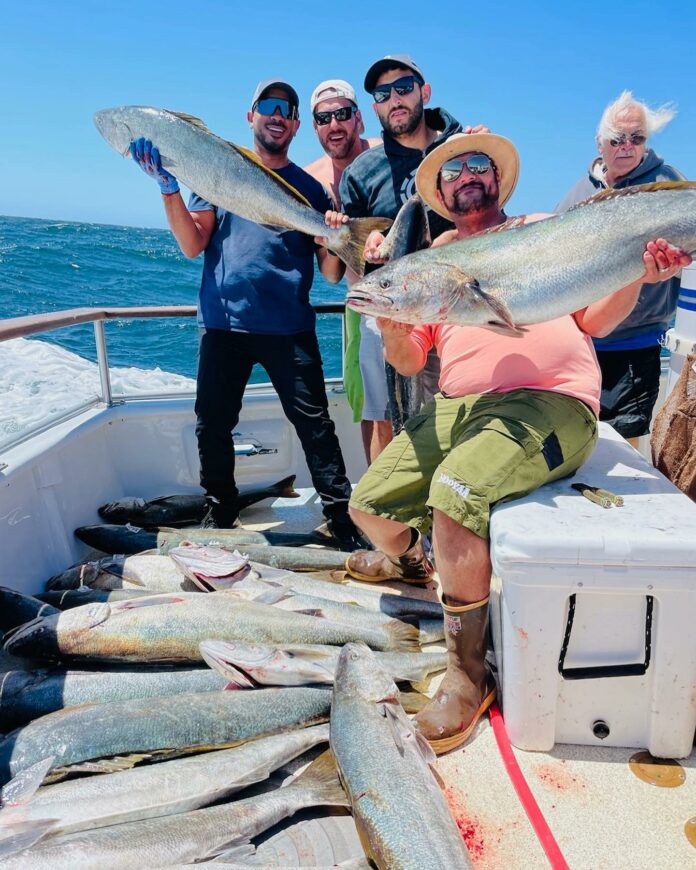Looking for a great Channel Islands Trip with tons of free giveaways? Book the WON Channel Islands Shootout out of Ventura on July 6, 2023 at https://wonews.com/charters/
BY MERIT MCREA
It’s the time of year for booking charters and spots on charters, even open party reservations for the coming spring season. But how do you pick the best day? There’s a confluence of factors to strive for.
The Santa Barbara Channel Islands are famous for phenomenal rockfishing, white seabass bites and huge halibut. While the rockfish opportunity is basically weather based – calm weather, broadest choice of fishing locations, seabass bets hinge on the ebb and flow of weather plus many other factors.
Seabass are all about finding food. They’ll gather around the best feeding opportunities they can find. In the Channel Islands the best angling opportunities coalesce around squid spawning cycles and locations.
It’s these opportunities that can last for more than a single opportune stop, remaining wide open for more than just a few fortunate moments and then gone like ghosts. When these fish are on a squid bed they will be biting in the same area for a few days, sometimes a few weeks.
Last spring the outer island bite appeared to come and go, but the reality was there was an area out in exposed waters that bit day after day, week after week. It was bouts of windy weather that kept the fleet from fishing it consistently and made the catches flux day to day.
In addition, there were other less consistent opportunities that provided some lucky catches as well.
So here’s the flow of factors. First, seasonality – these fish roam the coast, working their way north, first showing at the southern Islands like Catalina, usually in about late March to early April, then ever more arrive at the Channel Islands.
Squid spawns tend to peak during full moon periods, but will often continue at some level between times. Just before the full, nights are dark in the wee hours, making catching them for bait easier, which is key.
Seabass gathered for the feast will tend to get their fill early in the day and be sated by mid-morning, perhaps earlier.
After the full, the early morning hours are bright, as the moon doesn’t set until after sunrise. This makes bait getting a bit more challenging.
Often as the moon grows skinnier so will the amount of squid in the area, and there’s a trade-off between hungrier fish and fish beginning to spread out in their search, making them harder to get the boat on.
So there’s that, and generally it’s a good idea to target the days between the first and last quarters for a trip.
Mid June the limit on white seabass jumps from 1 fish per person to 3.
When it’s one, the chances of spreading out the catch so everyone gets a fair share are better, better chances of limiting the boat, then getting a bit more time fishing rockfish after.
When the limit is 3 seabass, the lucky anglers get big bags, and less fortunate can end up with very little, including fewer rockfish as more time is spent targeting seabass.
At the same time, it seems the halibut bite kicks into gear with some great opportunity for a huge flatfish in the mix. In general it takes an overnight trip to get into this kind of outer island bite.
But there are times when the croakers will be on squid spawns at the inner islands of Anacapa and east Santa Cruz, within easy 1-day range. This squid spawn fishing will still be better for the boats that get out on the grounds well before daylight.
But once the squid spawn slacks off in the eastern zones later in the season, making the fish hunt harder, the east island day bite can be a go-to as well – better weather on average too. But this is where these fish earn their moniker as “The Ghost,” here one moment then gone.
They will shift their diets to fin fish, anything from anchovies and sardines to mackerel, you name it. They will hunt in packs and schools, roaming widely.
Skippers will then spend a lot of effort and time working with the electronics, scanning sonar and up and down too. Anglers stand at the ready for an urgent announcement a school is under the boat and get a bait down there fast.
Sometimes these fish will head for heavy kelp and forage in a less schooling fashion. Then the strategy is to set up camp on the anchor and throw bait, lots of it, letting the fish find the boat instead and gather ‘round.
This typically results in mixed bag fishing, some barracuda, a few calico bass and a slow, but hopefully steady pick on the big croaker, perhaps with a few mossback yellowtail showing in the chum too.
While during the outer island squid spawn bite the big overnight boats can really whack the seabass, it’s the smaller charter boats that tend to have the best fortitude and fortune in the inner island full-day seabass game – think 6-pack to 20 passenger charter boats mostly.
The bigger open party ¾-day and full-day boats tend to have to head for rockfish and whitefish to keep their anglers entertained and smiling.
Finally, once waters hit the high 60s the fish move on, and into the secretive waters of the Central Coast where mostly private boaters target them.
Looking for a great Channel Islands Trip with tons of free giveaways? Book the WON Channel Islands Shootout out of Ventura July 6, 2023 at https://wonews.com/charters/
This story appears in the March 3, 2023 print edition of Western Outdoor News. To get early access to every info and feature-packed issue of the West Coast’s biggest and best outdoor sporting newspaper, click here




